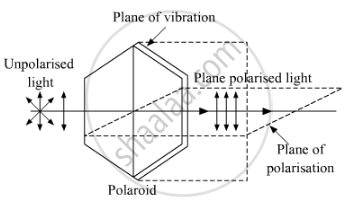Advertisements
Advertisements
प्रश्न
Why does an unpolarised light incident on a polaroid get linearly polarised ?
How does one get linearly polarised light with the help of a polaroid?
उत्तर १
When unpolarised light is passed through a polaroid crystal, only those vibrations of light pass through the crystal that are parallel to the axis of the crystal. All other vibrations will be absorbed by the crystal. In this way, the unpolarised light incident on a polaroid gets linearly polarised.

उत्तर २
We get linearly polarised light with the help of a polaroid as shown below:

The naked eye or the polariser cannot distinguish between unpolarised and plane polarised light. A crystal called analyser is used to analyse the nature of light.
If the axis of the polariser and the analyser are parallel to each other, the intensity of light is found to remain unaffected.
APPEARS IN
संबंधित प्रश्न
What dose a polaroid consist of?
Show, with the help of a diagram, how unpolarised sunlight gets polarised due to scattering.
The refractive indices of glass and water w.r.t. air are 3/2 and 4/3 respectively. Determine the refractive index of glass w.r.t. water.
Unpolarised light is passed through a polaroid P1. When this polarised beam passes through another polaroid P2 and if the pass axis of P2 makes angle θ with the pass axis of P1, then write the expression for the polarised beam passing through P2. Draw a plot showing the variation of intensity when θ varies from 0 to 2π.
What is the value of refractive index of a medium of polarising angle 60°?
Light transmitted by Nicol prism is ______.
What is a analyser?
What is unpolarised light?
What is partially polarised light?
Mention the types of optically active crystals with example.
